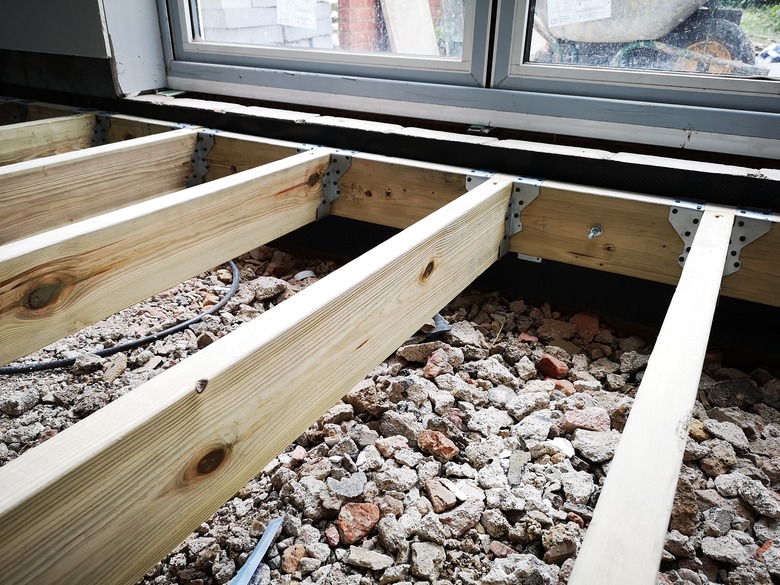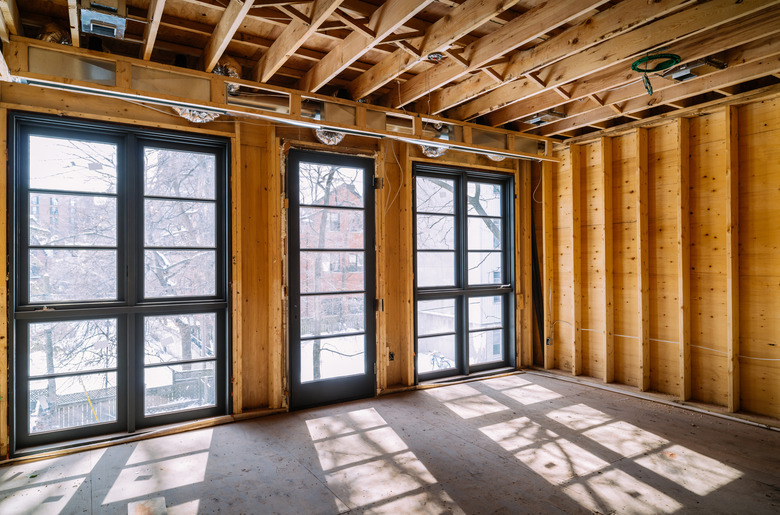Replacing Floor Joists: What You Should Know
If a floor joist is in such poor condition that it no longer offers adequate support for the floor above it, it may be time to replace that joist. Replacing joists is a major undertaking, so in many cases, it's best to call a pro to do the job. If you aren't sure whether the joists should be replaced or repaired or if there's another foundation issue causing the floor to lose its formerly level state, a structural engineer can help make that determination and calculate the best remedy to the problem.
Signs of Floor Joist Problems
Signs of Floor Joist Problems
The easiest way to tell that your floor may have joist problems is to simply walk across it. If you can feel the floor in one room sagging or even bowing upward, a joist could be to blame, according to the International Association of Certified Home Inspectors. If you aren't quite sure if the floor dips or bows, set a marble or a small ball on the floor near one corner of the room. If the floor dips, the marble should roll to the lower area. If you suspect the floor is higher in one area, place the marble in the suspected high spot and see if it rolls away.
Feel free to do the marble test from different areas of the room and even in adjacent rooms for comparison. This test works best on wood and other hard-surface, smooth floors, as the marble will not roll through thick carpet. In this case, a carpenter's level set on the floor in various locations helps indicate whether the floor is completely horizontal.
Severe termite problems, a fire or flooding may also result in compromised floor joists. If your home has undergone any such situation, inspect the joists even if the floor above them seems level and undamaged.
Inspecting Joists for Issues
Inspecting Joists for Issues
A good look at the floor joists will also help you determine if any need to be replaced. In order to see the joists without ripping up the floor, you'll need to access them from a crawlspace or an unfinished basement. Inspect the floor joists beneath the sagging or bowing area of the floor for any signs of damage. Severe water damage, rot, insect damage, twisting and splintering are all issues potentially indicating that a floor joist should be replaced. If the joist has been cut or drilled improperly to run wires, pipes or ducts beneath the floor, the joist may have lost some of its structural integrity.
If you aren't certain whether the affected joist should be replaced or if it can be repaired, ask a carpenter experienced in joist projects to take a look at the situation. Expect to spend around $100 for the assessment.
If you think numerous joists have issues or feel there may be a foundation problem, hire a structural engineer instead. The engineer is trained to spot potential issues that may not be obvious to the untrained eye, such as joists rotten on the inside, faulty support beams or foundation issues. Expect to spend $300 to $700 for the engineer's assessment, or approximately $100 to $150 per hour.
Shoring Up the Floor
If the floor sags or the problem joist spans the entire room, you'll have to bolster the floor with a temporary beam and a jack post. In some cases, a structural engineer may recommend two jack posts set equidistant across the span of the sag. This offers more support for the floor while you remove and replace the bad joist.
If you aren't sure how to tackle this, contact a professional rather than risking additional structural damage to your home — as cranking up the jack posts too high too fast could cause cracks and stress on the entire home structure. The floor should be raised no more than 1/4 inch per month to prevent structural problems.
- Nail two 2x4s together that are long enough to span several joists, including the damaged one. Nail those to the bottom of the joists spanning the damaged one in the area in which you wish to place the post jack.
- Insert a post jack beneath the new 2x4s atop a thick wood scrap large enough to support the jack. Follow the manufacturer's recommendations regarding wood size used for the project.
- Turn the nut, lever or handle on the jack in the direction indicated by the manufacturer to raise the jack's height slightly. Continue turning it slowly to increase its height until it cannot be wiggled free. Increase the height no more than another 1/4 inch to raise the sagging floor slightly.
- Continue the process, raising the floor 1/4 inch or less every month until the floor is level. Once it is level, the faulty joist can be replaced.
Replacing a Joist
Replacing a Joist
Replacing a floor joist is best left to a professional, especially if the joists are not easily accessible from a basement or crawlspace, as this means parts of the floor and subfloor must be removed to access each problematic joist. On the other hand, if you can see and access the joist easily from the basement and feel you can handle removing and replacing it yourself, set yourself up for success with a good work light and ample eye protection.
Keep a spare package of blades on hand for your reciprocating saw, as cutting through nails may break the blade. Make sure you measure the old joist end to end before cutting it out. It should be about 12 inches longer than the room it spans, but it may be only a few inches longer than the room. The new joist should be the same size so it sits atop the beams or foundation walls in the same manner as the old one.
- Pry the damaged joist from the subfloor using a crowbar or other pry bar, hammering wedges of wood between the subfloor and joist along the way to make your work easier.
- Once part of the joist is loosened, weaken it by cutting it vertically using a reciprocating saw. Work your way across the span of the joist, prying it free from the subfloor. Use the reciprocating saw to slice through nails when necessary. Remove pieces of the old joist until you've completely removed it from the project area.
- Apply a bead of construction adhesive to the top side of the new joist.
- Slide the new joist roughly into place, enlisting the help of a friend.
- Place a bottle jack alongside one end of the joist, positioning a block of wood atop the jack between the jack and the subfloor. Raise the jack and subfloor just enough to be able to tap the joist into proper position.
- Tap the joist into place. Fasten it to the supporting wall or beam at each end.
- Lower and remove the jack and the scrap block of wood.
Finding a Professional
Finding a Professional
The best way to ensure a quality joist replacement is to hire an experienced professional. Read general contractor and carpenter reviews on sites such as Angie's List and HomeAdvisor or ask your neighbors for recommendations. Local groups on social media sites can be an excellent resource for recommendations.
Call several contractors to get quotes, as their hourly rates and levels of expertise may vary. Expect to spend a minimum of $100 per joist replaced — or upward of $2,000 depending on the complexity of the removal and replacement. Labor adds another $100 to $150 per hour to the cost.
References
- Old House Journal: How to Fix Sagging Floors
- Bob Vila: 8 Things to Know Before Leveling a Floor
- International Association of Certified Home Inspectors: Evaluating Structural Framing
- HomeAdvisor: How Much Does it Cost to Hire a Residential Structural Engineer?
- Baker's Waterproofing: Repairing Sagging Floor Joists & Girders
- Acculevel: Can Floor Joists Be Repaired?
- Pro Trade Craft: How to Replace a Floor Joist—#TheHardWay
- Ask Jon Eakes: Adjusting a Jack Post (TelePost)


